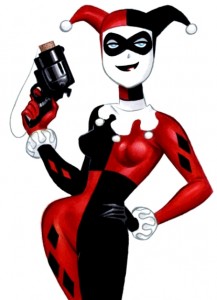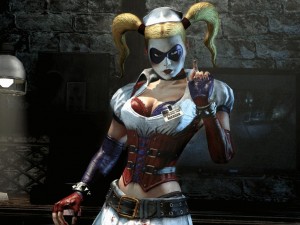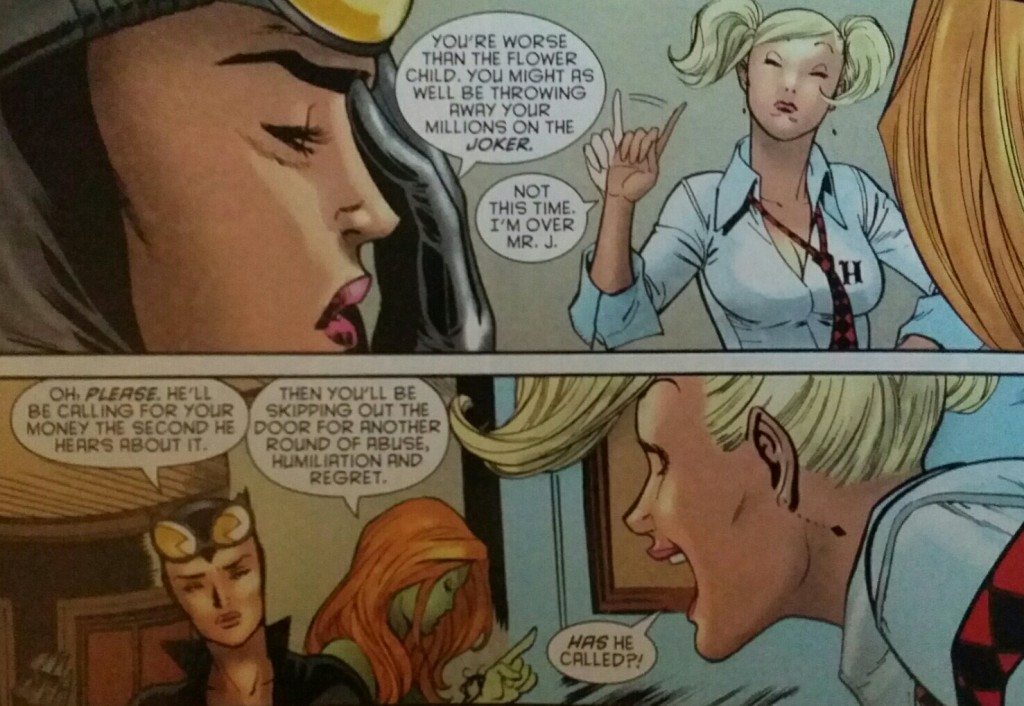Who is the real Harley Quinn? Is she the besotted lover of the Joker? Problematic “Hysterical Woman” trope? Feminist comic book icon? Fan favourite turned fourth pillar of the DCU? Let’s start at the beginning…

If you were a kid in the ’90s, it’s likely that you spent many a Saturday morning getting a formative education in superheroes. X-Men, Spider-Man, the Ninja Turtles, and Superman were all stalwart cereal accompaniment for the discerning early riser. Though many of these animated classics are looked back upon fondly, there was one show which critically outshone the others and is still seen by many as the defining portrayal of their favourite caped crusader: Batman: The Animated Series.
Created by Erik Radomski and Bruce Timm, BTAS is a dark and stylised take on the Batman lore. Influenced by both Tim Burton’s vision of Gotham and the best that the comics had to offer, the show was critically and commercially well-received. It sparked the beginning of DC’s animated continuity, which for a long time would be DC’s defining strength over Marvel. Out of the dark and surprisingly close-to-canon show came an original character. A foil for the Joker. A new woman in the DC universe. Her name was Dr. Harleen Quinzel.
“Joker’s Favor” was the incongruous mid-season episode that told the story of the Joker calling in some help from a man whose life he had spared years earlier. An important part of this plan includes a giant cake and a new face: Harley Quinn. Dressed in full Harlequin garb, her look would soon become as iconic as her irreverent wit and energy would become popular. Harley Quinn became a show regular and a year later was introduced into the DC Adventure’s comic canon in Batman Adventures #12.
Story has it that Harley was originally created to pop out of the aforementioned giant cake. In the finished episode it was the Joker who took that role as Harley enabled his escape, inadvertently giving the Joker his first sidekick—and creating a character whose reach and popularity no one at DC could have seen coming. It’s interesting to note that Harley was originally created in the pin-up mould, as it foreshadows the turbulent path and problematic treatment of the character in years to come.
To this day, Batman: The Animated Series remains my favourite representation of Batman. The addition of Harley in the first series was a complete revelation for me as a young girl who read comics and often related far more to the bad guys than the heroes. As an eight-year-old I saw a strong, funny, and smart woman in a world dominated by men. It would be much later that I realised how, for most of her formative years, those men defined her.
In 1994, DC released Mad Love by Bruce Timm and Paul Dini. Enshrined as the definitive Harley Quinn origin story, it tells the tale of Dr. Harleen Quinzel, a psychiatrist at Arkham Asylum who falls in love with her patient, the Joker. She becomes enamored with him after the Joker tells her he was abused as a child, and she finally helps him escape in the hope he may fall in love with her.
A popular book upon release (later adapted as an episode of BTAS), Mad Love does a great job of setting up the toxicity of Harley’s relationship with the Joker, but also showcases the creators’ toxic relationship with Harley. The Joker clearly establishes the structure of the abusive relationship that would come to define the pair. Even more notably, the creators not only paint Harley as needy and obsessed but they strongly imply that she slept her way through college and was not a genuinely qualified psychiatrist at all. Giving an established and popular female character an extended backstory seems like an exciting and progressive thing to do. But in the case of Mad Love, the backstory painted Harley as a weak, morally corrupt woman who “uses” men to get what she wants.

DC’s history of doing terrible things to female characters is long and varied. The murder of Kyle Rayner’s girlfriend Alexandra DeWitt in Green Lantern #54 was an act so callous and unnecessary it coined a whole new term, fridging, to describe killing a woman to further a male character’s narrative. The now notorious sexual assault and shooting of Barbara Gordon in the seminal Killing Joke is a perpetual sticking point in conversations around treatment of women in comics. Gordon’s treatment has somehow become worse in the recent animated adaptation—she now has a sexual relationship with Batman to make it more emotional for him. Compared to the recent, incredibly popular, and positive Babs Tarr and Brenden Fletcher Batgirl run, this feels like an especially egregious case of male creators adding unnecessary and negative backstory to a character who had, against the odds, managed to inspire a loving and predominantly non-male fandom.
Fandom is as important to the story of Harley as any of the actual books. When you are a comics fan who also happens to be part of a marginalised and rarely represented group, you find your representation yourself. You create headcanon, define your own place within the thing that you love so much, and find yourself in the rare representations in which you are presented. Harley Quinn is synonymous with this mindset. Not only is this her own method of operation, Harley’s look and attitude make her a firm favourite. Even if she didn’t hit the mainstream til years later, she was still a cult icon in the making.
In 1999, Paul Dini returned to Harley’s origin in the one shot Batman: Harley Quinn with Yvel Guichet. Dini painted a picture of Harley as Harleen, trapped in Arkham after helping her beloved escape until an earthquake frees her. After being betrayed by the Joker, she is found by Poison Ivy and nursed back to health. Building on an episode of the animated series, this sets up an important part of Harley’s story as Ivy gives her a serum which makes her impervious to poisons. It’s also a vital part of the relationship origin between the two characters, which would later evolve into one of the more inspired stories within DC canon. This book marked Harley’s official entry into the main DC comics canon, where she quickly became the most notable addition to the universe from the animated continuity.

Harley was given her own title in 2001. Harley Quinn was an ongoing book that told of our titular heroine’s adventures, written by Karl Kesel and drawn by Terry Dodson, which ran for 38 issues. This book was one of the first to really have Harley question her love for the Joker, but it was a topic that, though hinted at, was never fully explored. She made guest appearances in other popular DC titles including Batman: Hush and Countdown to Final Crisis, in which interestingly Harley is a tenant at an Athenian Women’s Shelter, seemingly living her life as an Amazon. In the mid-00s, Harley’s solo title ended whilst she was given a mini series. It harkened back to her origins by teaming her up with Poison Ivy. Harley and Ivy saw Paul Dini return to his creation, cultivating even more of a cult following for the pairing of these femme fatales.
Around this time, DC was going through many changes. After the comics boom in the ’90s, both DC and Marvel had fallen on hard times. By 2004, Marvel began to reverse their ailing fortunes in the direct market as with a plan to self-finance their own films, which would lead to a multi-billion dollar sale to Disney less than six years later. Meanwhile, as DC’s comic book sales lagged, Catwoman hit theaters and cemented the company’s reputation as a stagnant brand. Looking at the editorial choices during this time proves to be a great microcosm for what DC thought would sell. In the year following the cancellation of Harley Quinn, the publisher released Identity Crisis, another infamous story which uses the unnecessary rape of a longtime female character as a plot device.

Harley lay largely dormant for the next few years. But in 2009 something unprecedented happened to the Batman franchise that changed the face of Harleen Quinzel forever. Tie-in video games are often an afterthought, badly conceived and rarely leaving a lasting impression on fans. Arkham Asylum bucked that trend, receiving critical and commercial success along with accolades, including numerous Game Of The Year awards. To fit in with this grim and gritty Gotham of the game, Harley underwent a complete redesign. Gone were the classic Harlequin outfit and cheery villainy. In were ridiculously revealing outfits and Male Gaze-approved cleavage shots. This wasn’t your daughter’s Harley.
The Arkham series became steadily more successful, and alongside the generally raised awareness of comics in popular culture, this solidified Harley as one of DC’s biggest characters. Her recognition had been a long time coming, yet it was a shame that it came out of a game which reduced her to a sexualised sidekick, a tropey videogame girl lacking the humour and complexity that made her a hit with fans in the first place. Whilst all of this was going on in the gaming world, Paul Dini was back at it again, writing one of his most complex and interesting Harley books, Gotham City Sirens. Sirens focuses on the women of Gotham, who are all notably criminals. The book itself is actually a great meditation on female friendship, toxic relationships, and the villain/anti-hero dichotomy. It would also be the last Harley book before DC’s infamous New 52 Relaunch.


But Harley’s Arkham redesign was seen as such a hit that it actually made the transition into the comics with the New 52 Suicide Squad title, complete with an addition to her origin to explain her new bleached skin: the Joker, her beloved, had kicked her into a vat full of acid, burning her skin and turning it white. Once again, the ease with which DC will physically harm a female character for the sake of plot (or, in this case, AESTHETIC) is truly astounding. Harley was a main character in the Suicide Squad run, and once again proved to be hugely popular with fans. So it came as no surprise that they later announced a solo Harley title under the New 52 banner with the wonderful creative team of Jimmy Palmiotti and the incredible Amanda Conner. Though, as with anything to do with women and DC, the path to a good Harley book would not be a smooth one.
Can you imagine a scenario in which Batman would ever kill himself? While I can certainly fathom his suicidal motivation (he’s very upset about his parents’ death, clearly has a lot of unresolved anger and guilt, and he’s incredibly lonely and rich), it’s fairly implausible. Now please take a moment to consider this—imagine a fan competition where fans were asked to draw Bruce Wayne committing suicide. It seems preposterous, like it could never possibly happen, right?
While DC never asked its fans to give Bruce the Kevorkian treatment, they had no compunctions about asking for people to help them off another member of the Batman Family. “Break Into Comics With Harley” was a very real “talent search” that asked fans to draw a naked Harley in the bath attempting suicide. This competition said so much about the disposable nature of female characters in comics. It broke the fourth wall of the great tradition of fridging women.
Unsurprisingly, “Break Into Comics With Harley” was badly received. This was in 2013, literally a few years ago. This was something that numerous people sat around a table and agreed upon. Then other people signed off on it. That really sums up the attitude that has created such problematic themes and treatment of women at DC. The finished page was far more subdued and abstract after the rightful backlash. But trying to create a humorous narrative around the idea of an abused woman attempting to end her life is just wrong. It’s completely irresponsible and shows a lack of respect for both the character and the fans, which has long been DC’s problem.
Over the past few years there has been a slow but steady change in the comics landscape. A more diverse roster of characters are appearing on our pages. More varied stories are being told and more diverse creators are finally being hired. There is still a long way to go, but the face of comics is changing and with it so is the way in which characters are treated. In Conner and Palmiotti’s solo Harley Quinn book, drawn by Chad Hardin, Harley is a recovering abuse victim, redefining herself without the Joker or the Bat Family. In issue 25, Harley even gets some long awaited revenge on Mistah J himself in one of the best pieces of true fan service that I’ve read in a long time. Alongside the success of the book, Conner and Palmiotti confirmed a longstanding fan headcanon when they stated that Harley and Ivy were in a long term, non-monogamous relationship. The book finally established Harley as her own person, and bought her to the forefront of the DC Comics Universe.
The first issue of the series was DC and Diamond’s second highest selling issue of that period. The title also did something oft unheard of for a mainstream superhero comic, regaining traction after a slight dip in sales and rising to higher numbers than previous issues! Harley was a bonafide hit. At one point in 2015, she was the star of seven different titles.
Harley’s skyrocketing popularity at DC also has a second series to thank: DC Bombshells by Marguerite Bennett and Marguerite Sauvage. An AU story of DC’s female superheroes on the front line of World War II, this was another fantastic and fantastically popular book that put Harley center stage as one of its main protagonists. Jim Lee soon called Harley “The Fourth Pillar of DC” and alluded to her as an equal among Batman, Superman, and Wonder Woman, representing her landmark position in superhero history. All of this recognition and success is for a character who was originally nothing but a sexy walk-on part. Thanks to belief in her concept from various quarters, Harley has grown to become much, much more than the sum of her parts and represents a huge step forward for DC.
This month, DC’s newest addition to their cinematic universe is released. Suicide Squad marks the debut of Harley Quinn in DC movie continuity. With a starring role in one of the summer’s biggest box office hits, alongside an upcoming DC Rebirth title and a level of popularity she’s never seen before, this is finally the time for Harley Quinn’s star to eclipse the Joker, and shine brighter than ever before.





